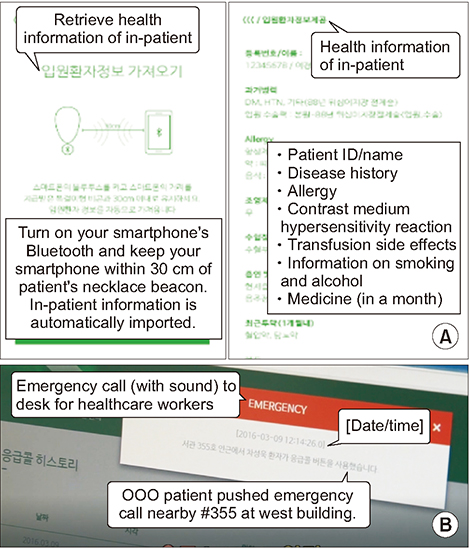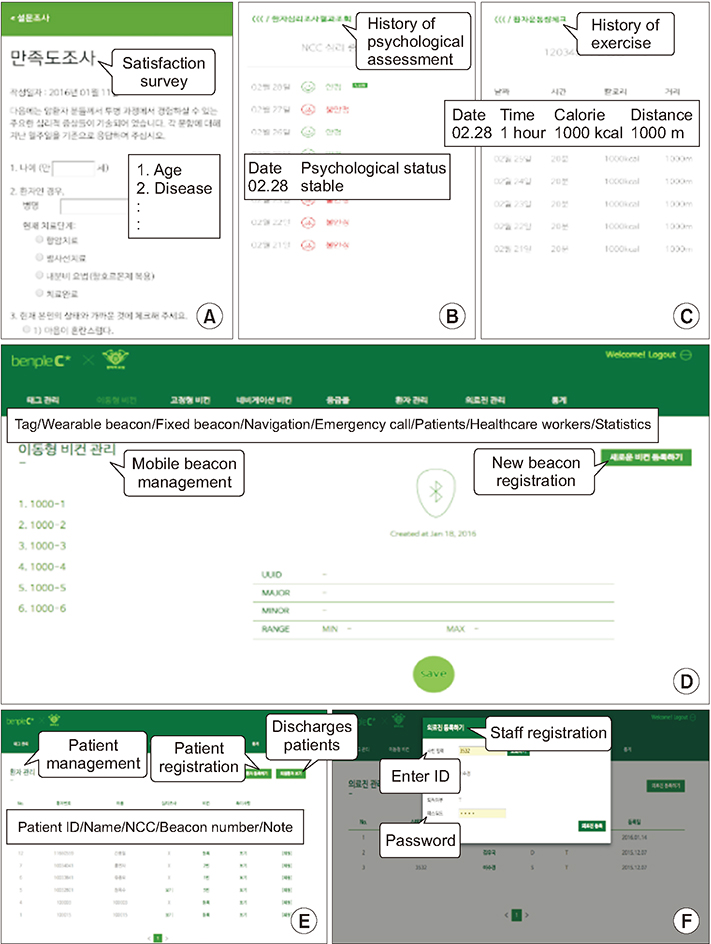Healthc Inform Res.
2018 Oct;24(4):387-393. 10.4258/hir.2018.24.4.387.
How to Sustain Smart Connected Hospital Services: An Experience from a Pilot Project on IoT-Based Healthcare Services
- Affiliations
-
- 1School of Management, Kyung Hee University, Seoul, Korea. klee@khu.ac.kr
- KMID: 2434555
- DOI: http://doi.org/10.4258/hir.2018.24.4.387
Abstract
OBJECTIVES
This paper describes an experience of implementing seamless service trials online and offline by adopting Internet of Things (IoT) technology based on near-field communication (NFC) tags and Bluetooth low-energy (BLE) beacons. The services were provided for both patients and health professionals.
METHODS
The pilot services were implemented to enhance healthcare service quality, improve patient safety, and provide an effective business process to health professionals in a tertiary hospital in Seoul, Korea. The services to enhance healthcare service quality include healing tours, cancer information/education, psychological assessments, indoor navigation, and exercise volume checking. The services to improve patient safety are monitoring of high-risk inpatients and delivery of real-time health information in emergency situations. In addition, the services to provide an effective business process to health professionals include surveys and web services for patient management.
RESULTS
Considering the sustainability of the pilot services, we decided to pause navigation and patient monitoring services until the interference problem could be completely resolved because beacon signal interference significantly influences the quality of services. On the other hand, we had to continue to provide new wearable beacons to high-risk patients because of hygiene issues, so the cost increased over time and was much higher than expected.
CONCLUSIONS
To make the smart connected hospital services sustainable, technical feasibility (e.g., beacon signal interference), economic feasibility (e.g., continuous provision of new necklace beacons), and organizational commitment and support (e.g., renewal of new alternative medical devices and infrastructure) are required.
Keyword
MeSH Terms
Figure
Reference
-
1. Evans D. Internet of Things: the evolution of the internet changing everything [Internet]. San Jose (CA): Cisco IBSG;2011. cited at 2018 Oct 1. Available from: https://www.cisco.com/c/dam/global/ko_kr/assets/executives/pdf/internet-of-things-iot-ibsg-0411final.pdf.2. International Telecommunications Union. The Internet of Things [Internet]. Geneva, Switzerland: International Telecommunications Union;2005. cited at 2018 Oct 1. Available from: https://www.itu.int/net/wsis/tunis/newsroom/stats/The-Internet-of-Things-2005.pdf.3. Deloitte Insights. The Internet of Things: a technical primer [Internet]. New York (NY): Deloitte Insights;2018. cited at 2018 Oct 1. Available from: https://www2.deloitte.com/content/dam/insights/us/articles/4420_IoT-primer/DI_IoT-Primer.pdf.4. Porter ME, Heppelmann JE. How smart, connected products are transforming competition. Harv Bus Rev. 2014; 92(11):64–88.5. Porter ME, Heppelmann JE. How smart, connected products are transforming companies. Harv Bus Rev. 2015; 93(10):96–114.6. Yao W, Chu CH, Li Z. The adoption and implementation of RFID technologies in healthcare: a literature review. J Med Syst. 2012; 36(6):3507–3525.
Article7. Park A, Chang H, Lee KJ. Action research on development and application of Internet of Things services in hospital. Healthc Inform Res. 2017; 23(1):25–34.
Article8. Kim J, Kam HJ, Park YR, Yoo S, Oh JS, Kim YH, et al. Enchanted life space: adding value to smart health by integrating human desires. Healthc Inform Res. 2018; 24(1):3–11.
Article9. Lee KJ, Jun JH. Internet of Things and business opportunity [Internet]. Seoul, Korea: Dong-A Business Review;2014. cited at 2018 Sep 24. Available from: http://dbr.donga.com/article/view/1101/article_no/6593.10. Chesbrough H, Rosenbloom RS. The role of the business model in capturing value from innovation: evidence from Xerox Corporation's technology spin-off companies. Ind Corp Change. 2002; 11(3):529–555.
Article11. Dexcom G5 mobile CGM system [Internet]. San Diego (CA): Dexcom Inc.;c2018. cited at 2018 Sep 13. Available from: https://www.dexcom.com/g5-mobile-cgm.12. BGStar [Internet]. Paris, France: Sanofi;c2018. cited at 2018 Sep 13. Available from: https://www.mystarsanofi.com/products/bgstar.
- Full Text Links
- Actions
-
Cited
- CITED
-
- Close
- Share
- Similar articles
-
- Recent Patient Health Monitoring Platforms Incorporating Internet of Things-Enabled Smart Devices
- Action Research on Development and Application of Internet of Things Services in Hospital
- Service-Oriented Security Framework for Remote Medical Services in the Internet of Things Environment
- Practical Experiences of Practitioners and Policy Implications in the Community-Based Integrated Care Pilot Project for People with Mental Disabilities
- Comparison of Medical Use and Cost between IoT Users and Non-Users according to the Use of IoT in Home-Based HospicePalliative Care




